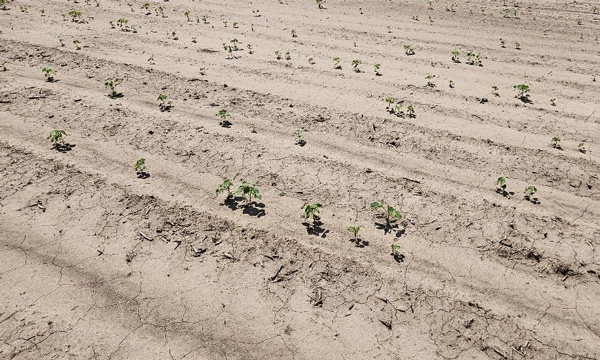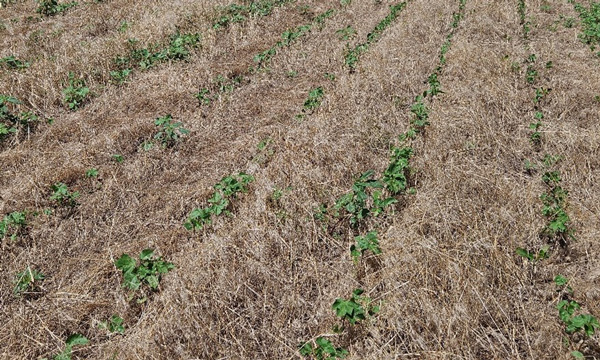The 2025 growing season in Kansas has been challenging for many of our major crops, and cotton has been no exception. High winds and heavy rain have significantly damaged cotton stands in some parts of the state (Figure 1). While some stands of no-till cotton planted into heavier residue were protected and remain in good shape (Figure 2). Residue was key this year! For the damaged cotton stands, some producers may be considering terminating the cotton and switching crops. Several points must be considered before making this decision.

Figure 1. High winds and heavy rains resulted in reduced and non-uniform cotton stands. Photo courtesy of Rex Friesen, Southern Kansas Cotton Growers.

Figure 2. Crop residue protects sensitive cotton seedlings during high winds and heavy rain events. Photo courtesy of Rex Friesen, Southern Kansas Cotton Growers.
Should I keep my cotton?
Don’t give up on your cotton crop too soon. Cotton is an indeterminate crop with a strong ability to recover and compensate for setbacks. Even in low populations—such as one plant per 30-inch row (about 17,500 plants per acre)—acceptable yields are still possible (see Table 1). However, non-uniform or sparse stands can lead to uneven and delayed maturity, which increases the risk of significant yield losses later in the season. Some fields in south central Kansas, for instance, have already been adjusted to yields as low as 10 pounds per acre.
Table 1. Plant populations at various row spacings.
|
Plants/foot |
Row spacing (inches) |
||||
|
15 |
30 |
36 |
38 |
40 |
|
|
Plants/acre |
|||||
|
1 |
34,848 |
17,424 |
14,520 |
13,756 |
13,068 |
|
2 |
69,696 |
34,848 |
29,040 |
27,512 |
26,136 |
|
3 |
104,544 |
52,272 |
43,560 |
41,268 |
39,204 |
|
4 |
139,392 |
69,696 |
58,080 |
55,024 |
52,272 |
|
5 |
174,240 |
87,120 |
72,600 |
68,780 |
65,340 |
Can I switch to soybeans or sorghum?
Soybean or sorghum could be options to follow failed cotton in Kansas. However, the most important consideration before switching crops is the potential rotation restrictions based on any residual herbicides that might have been applied. Where group 5 herbicides like fluometuron (Cotoran) or prometryn (Caparol) have been applied, DO NOT plant soybeans. However, soybeans can be planted following group 15 herbicides like acetochlor (Warrant, others), S-metalochlor (Dual, others), dimethenamid-P (Outlook), or pyroxasulfone (Zidua). Concep-treated sorghum can be planted where encapsulated acetochlor (Warrant or Enversa), S-metalochlor, or dimethenamid-P have been applied. DO NOT plant sorghum where fluometuron, prometryn, or pyroxafulfone have been applied.
Regardless of which crop is replanted, the current cotton stand should be removed. Herbicides that could be used to terminate the current stand would be saflufenacil (Sharpen), tiafenacil (Reviton), or paraquat (Gramoxone, others).
Managing soybeans or sorghum planted after failed cotton
For soybeans and sorghum following the failed cotton, it is important to consider soil fertility, variety selection, as well as seeding rate and row spacing. No additional fertility may be required if the full rate for cotton has already been applied and following with sorghum
In the case of soybean variety selection, a variety with the same or perhaps even slightly later maturity rating as a typical planting date for full-season soybeans will allow the plant to develop a large enough canopy before flowering. An earlier maturing variety will result in short plants with pods set close to the ground, while planting a much later variety increases the risk of immature pods at frost. Unlike soybeans, an earlier maturing sorghum hybrid should be selected to follow failed cotton. Sorghum development is primarily driven by the accumulation of heat units, and the remaining growing season is too short to allow medium-late or late hybrids to mature before the first frost in most of Kansas.
Both soybeans and sorghum can benefit from increasing seeding rates and narrowing row spacing (30” to 15”) when planting late. Increasing seed rate and narrowing row spacing can speed up canopy development, which helps with early-season light capture, suppressing weeds, and reducing erosion.
Crop insurance implications
Producers can claim no more than 135% on a given acre in a crop season. Two scenarios that could occur would be 1) a producer make a 100% claim on their cotton as the first and primary crop and 35% of their second crop (soybean or sorghum) or 2) a producer could make a claim of only 35% of their cotton as the first crop and retain the ability to claim 100% of the second crop (soybean or sorghum).
It is important to note that soybeans or sorghum planted after failed cotton will be insured as a full-season crop (not a double crop). The cutoff for full coverage of a full-season soybean or sorghum crop in Kansas was June 25. However, both crops can be insured as late-planted with 1% cover loss for every day following June 25 until July 20.
Other resources
- 2025 Chemical Weed Control Guide (KSU Extension)
- Failed Cotton Herbicide Rotation Restrictions to Soybean in Oklahoma (OSU Extension)
- Failed Cotton Herbicide Rotation Restrictions to Sorghum in Oklahoma (OSU Extension)
Logan Simon – Southwest Area Agronomist
lsimon@ksu.edu
Tina Sullivan – Northeast Area Agronomist
tsullivan@ksu.edu
Sarah Lancaster – Extension Weed Scientist Specialist
slancaster@ksu.edu
Tags: weather replanting cotton